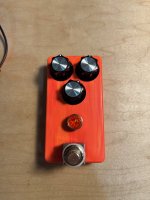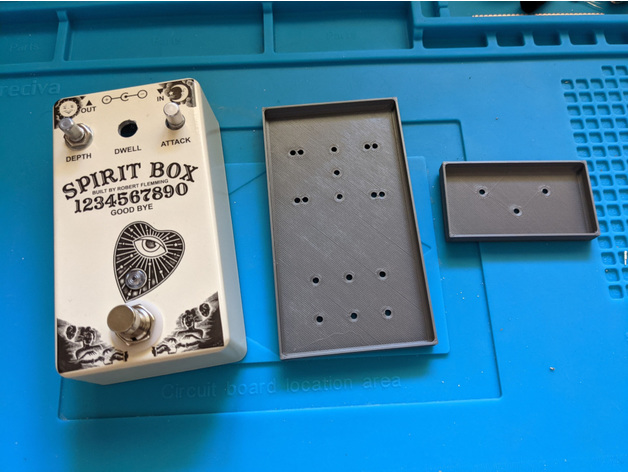falco_femoralis
Well-known member
Hi all, in my other build threads I pick up after the holes have been drilled and focus more on installing the PCB into the enclosure and wiring it up. I wanted to detail my process for drilling each enclosure this time. It is pretty tedious but there is a flow I get into and it's not that bad.. if I don't stop to take pics.
Starting with the bare enclosure I try to see if there are any irregularities I want to stand out or imperfections to cover up. This one has a nice yellow detail near the top which would be covered up by the knobs so I flipped it upside down from this perspective

Then I place the components on top of the pedal and get an idea of what knobs to use. I recently picked up some of these synth knobs, which I like because they are kind of like Boss knobs but more elegant. These are the skirted style

And these are the non-skirted

I went with the skirted ones
then I grab all the components and bring them over to the drill work bench

I cover it with painter's tape and make note of which end is the top. I make sure to mask off the top and bottom edges as well as at least half of each side as well, and I fold the ends of the tape over to the inside of the enclosure

Here are some notes I made to remember the center lines of a few enclosure sizes

Using my combination square as a depth gauge I mark the center

Then double check it from the other side. This one I got on the first try

Then I do it again so I can have two points of reference in addition to the square's shoulder when drawing the center line

I carry the line over the top of the enclosure so I can locate the power jack. This one got a little wonky so I redrew the line and the arrow indicates the correct line to follow later

Now I'm starting to dial in the knob spacing. I try to have the spacing from the edge of each upper knob to the edges of the enclosure, as well as the distances between each knob, be either consistent or proportional to each other. Each style knob is slightly different so
I do this by placing the knobs on the enclosure and eyeing it up

Then I continue the marks across the face of the pedal

I double check that it's what I wanted,

and it is, so I move on to locating the two upper knobs horizontally, again by eye

and then I double check using the combo square as a depth gauge

and it's spot on so I can move on

I continue the marks into lines with the square

I place the knobs back on the enclosure and work out where I want the switch and led jewel to go. I like having the switch as close to the bottom as I can, and I like placing the jewel mostly in the middle between the switch and the tone knob, but slightly favoring the switch. When that's worked out I mark their centers and again continue it into a line using the square

Same thing with the power jack

Starting with the bare enclosure I try to see if there are any irregularities I want to stand out or imperfections to cover up. This one has a nice yellow detail near the top which would be covered up by the knobs so I flipped it upside down from this perspective

Then I place the components on top of the pedal and get an idea of what knobs to use. I recently picked up some of these synth knobs, which I like because they are kind of like Boss knobs but more elegant. These are the skirted style

And these are the non-skirted

I went with the skirted ones
then I grab all the components and bring them over to the drill work bench

I cover it with painter's tape and make note of which end is the top. I make sure to mask off the top and bottom edges as well as at least half of each side as well, and I fold the ends of the tape over to the inside of the enclosure

Here are some notes I made to remember the center lines of a few enclosure sizes

Using my combination square as a depth gauge I mark the center

Then double check it from the other side. This one I got on the first try

Then I do it again so I can have two points of reference in addition to the square's shoulder when drawing the center line

I carry the line over the top of the enclosure so I can locate the power jack. This one got a little wonky so I redrew the line and the arrow indicates the correct line to follow later

Now I'm starting to dial in the knob spacing. I try to have the spacing from the edge of each upper knob to the edges of the enclosure, as well as the distances between each knob, be either consistent or proportional to each other. Each style knob is slightly different so
I do this by placing the knobs on the enclosure and eyeing it up

Then I continue the marks across the face of the pedal

I double check that it's what I wanted,

and it is, so I move on to locating the two upper knobs horizontally, again by eye

and then I double check using the combo square as a depth gauge

and it's spot on so I can move on

I continue the marks into lines with the square

I place the knobs back on the enclosure and work out where I want the switch and led jewel to go. I like having the switch as close to the bottom as I can, and I like placing the jewel mostly in the middle between the switch and the tone knob, but slightly favoring the switch. When that's worked out I mark their centers and again continue it into a line using the square

Same thing with the power jack

Last edited:






























































